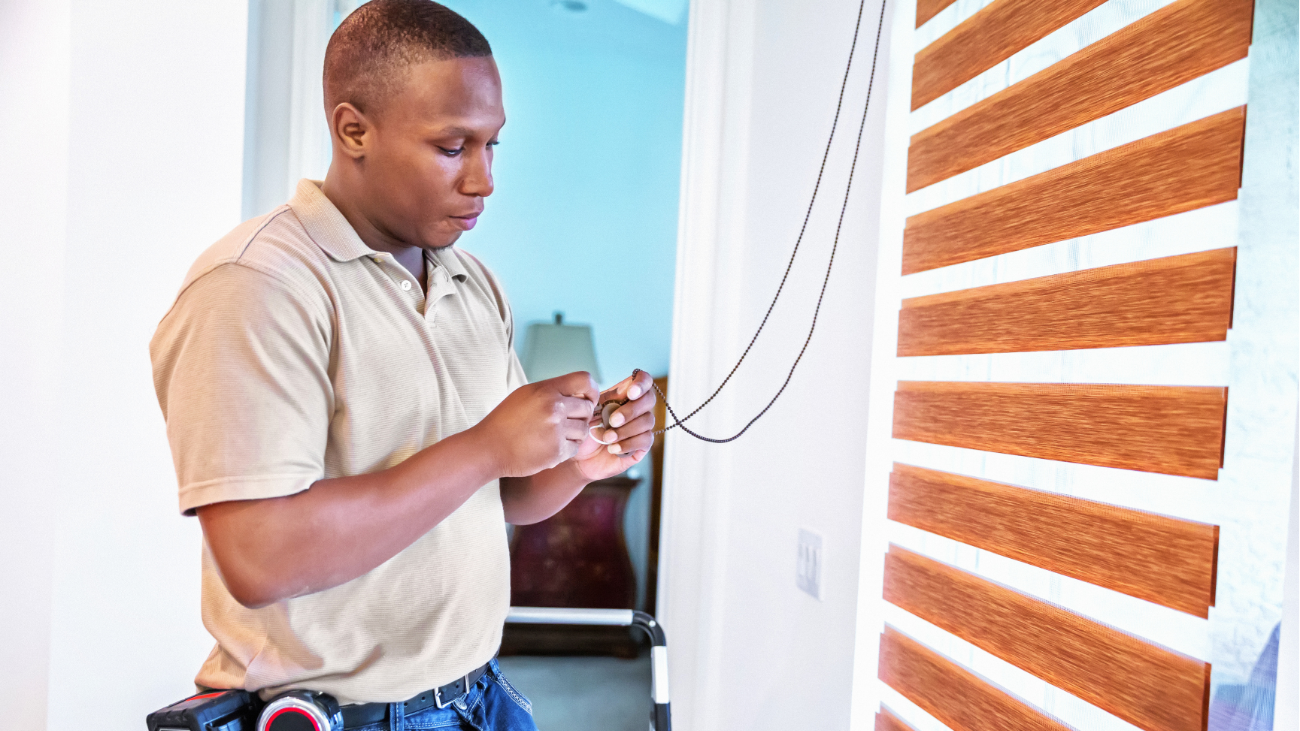In today’s fast-paced world, finding peace and quiet at home has become more challenging than ever. Whether you live in a bustling urban area, near a busy road, or next to noisy neighbors, unwanted noise can disrupt your daily life and affect your overall well-being. One of the most effective ways to reduce noise pollution in your home is through soundproofing, and window treatments can play a significant role in this process. In this blog, we’ll explore how you can use window treatments to soundproof your home, enhancing your comfort and creating a serene living environment.
Understanding Noise Pollution and Its Impact
Before diving into the details of soundproofing with window treatments, it’s important to understand what noise pollution is and how it can affect you. Noise pollution refers to unwanted or harmful sounds that disrupt the natural balance of our environment. Prolonged exposure to high levels of noise can lead to various health issues, including stress, anxiety, sleep disturbances, and even cardiovascular problems.
Windows are one of the primary entry points for noise in a home, making them a key area to address when soundproofing. By choosing the right window treatments, you can significantly reduce the amount of noise that enters your home, creating a more peaceful and comfortable living space.
Achnowleging The Role of Window Treatments in Soundproofing
Window treatments are often thought of as decorative elements, but they can also serve a functional purpose in soundproofing. Different types of window treatments have varying levels of effectiveness in reducing noise, depending on their materials, thickness, and installation.
1. How Window Treatments Block Noise
Sound travels in waves, and when these waves hit a solid surface, some of the sound is absorbed, some is reflected, and some passes through. The goal of soundproofing is to minimize the amount of sound that passes through the windows by absorbing and reflecting as much noise as possible.
Window treatments help block noise by adding layers of material between the outside world and your living space. Thicker, denser materials are more effective at absorbing sound waves, while certain designs and installation techniques can help to seal gaps around the windows, reducing the amount of noise that can enter.
2. Types of Window Treatments for Soundproofing
There are several types of window treatments that can be used to reduce noise pollution in your home. Each type has its own advantages and can be combined with other treatments for maximum effectiveness.
- Heavy Drapes and Curtains
One of the most effective ways to soundproof your windows is by using heavy drapes or curtains. These window treatments are made from thick, dense fabrics that can absorb sound waves and reduce the amount of noise that enters a room.
- Material Matters: When selecting drapes for soundproofing, opt for fabrics like velvet, wool, or heavy cotton. These materials are dense and can help block sound more effectively than lighter fabrics like sheer or lace curtains.
- Double Layering: For even better soundproofing, consider double-layering your drapes. This involves hanging two sets of curtains, one behind the other, to create an extra barrier against noise. The combination of materials and the air gap between the layers can significantly enhance the soundproofing effect.
- Floor-to-Ceiling Coverage: Ensure that your drapes extend from the ceiling to the floor and are wide enough to cover the entire window. This will help to seal off any gaps where sound could enter, providing better overall noise reduction.
- Acoustic Curtains
Acoustic curtains are specially designed for soundproofing and are made from materials that are specifically engineered to block and absorb noise. These curtains are typically thicker and heavier than standard drapes and often feature multiple layers of sound-absorbing material.
- Noise Reduction Ratings: Acoustic curtains often come with a Noise Reduction Coefficient (NRC) rating, which measures the effectiveness of the material in absorbing sound. The higher the NRC rating, the better the curtains will be at reducing noise.
- Thermal Insulation: Many acoustic curtains also offer thermal insulation, which can help to keep your home warmer in the winter and cooler in the summer. This dual functionality makes them a great investment for both soundproofing and energy efficiency.
- Installation Tips: For the best results, install acoustic curtains as close to the window as possible and ensure they overlap the window frame to block any gaps where noise could enter.
- Cellular Shades
Cellular shades, also known as honeycomb shades, are another excellent option for soundproofing. These window treatments are made from pleated fabric that forms a series of honeycomb-shaped cells when the shade is lowered. The cells trap air, creating a barrier that helps to reduce noise.
- Multiple Layers: Cellular shades are available in single, double, or triple-cell designs. The more layers of cells, the better the shades will be at insulating against sound.
- Energy Efficiency: In addition to soundproofing, cellular shades are also highly energy-efficient. The trapped air within the cells acts as an insulating layer, helping to regulate the temperature in your home and reduce energy costs.
- Customization: Cellular shades come in a wide range of colors and opacities, allowing you to customize the look of your window treatments while still enjoying the benefits of soundproofing.
- Window Quilts
Window quilts are similar to cellular shades but offer even more insulation and soundproofing. These treatments consist of a quilted fabric panel that can be rolled up or down to cover the window. The thick, padded material is highly effective at blocking noise and can also help to insulate against heat and cold.
- Ease of Use: Window quilts are easy to install and use, making them a convenient option for those looking to quickly improve their home’s soundproofing.
- Custom Fit: Like cellular shades, window quilts can be custom-made to fit your windows perfectly, ensuring maximum coverage and noise reduction.
- Seasonal Use: While window quilts are effective year-round, they are particularly beneficial during the winter months when additional insulation is needed to keep your home warm.
- Shutters
Shutters are a more permanent window treatment option that can provide excellent soundproofing benefits. Made from solid materials like wood or vinyl, shutters create a sturdy barrier that helps to block out noise.
- Interior vs. Exterior Shutters: Both interior and exterior shutters can be effective at reducing noise, but exterior shutters tend to offer better protection since they block noise before it reaches the window.
- Material Considerations: Wooden shutters are typically more effective at soundproofing than vinyl, but they may require more maintenance. If you’re looking for a low-maintenance option, consider composite shutters, which combine the durability of wood with the ease of vinyl.
- Custom Fit: For the best soundproofing results, shutters should be custom-fitted to your windows. This ensures a snug fit that minimizes gaps where noise could enter.
3. Additional Tips for Soundproofing Windows
While window treatments can significantly reduce noise pollution, there are additional steps you can take to enhance the soundproofing of your windows.
- Seal Gaps and Cracks – Even the best window treatments won’t be fully effective if there are gaps or cracks around your windows. Use weatherstripping or caulk to seal any openings where noise could enter. This simple step can make a big difference in reducing noise levels.
- Use Window Inserts – Window inserts are another option for improving soundproofing. These are clear, acrylic panels that fit inside your existing window frames, creating an additional barrier against noise. Window inserts are easy to install and can be removed when not needed.
- Install Double or Triple-Glazed Windows – If you’re serious about soundproofing, consider upgrading to double or triple-glazed windows. These windows feature two or three panes of glass with a layer of air or gas between them, which helps to block sound waves. While this option requires a more significant investment, it can provide substantial noise reduction and improve the overall energy efficiency of your home.
- Add Rugs and Carpets – Soundproofing isn’t just about windows; it’s about reducing noise throughout your home. Adding rugs, carpets, and other soft furnishings can help to absorb sound and reduce echo, creating a quieter environment overall.
- Combining Window Treatments for Maximum Soundproofing – For the best soundproofing results, consider combining multiple window treatments. For example, you could use acoustic curtains in conjunction with cellular shades or shutters. Layering different treatments creates multiple barriers against noise, making it harder for sound to penetrate your home.
By thoughtfully selecting and combining window treatments, you can create a more peaceful and serene living environment, even in the noisiest of neighborhoods.
Conclusion:
Soundproofing your home with window treatments is an effective way to reduce noise pollution and create a more comfortable living space. Whether you opt for heavy drapes, acoustic curtains, cellular shades, or shutters, there are plenty of options to suit your style and needs. By understanding how different window treatments work and how to combine them for maximum effect, you can enjoy a quieter, more tranquil home. Take the time to explore your options and invest in the right window treatments to transform your home into a peaceful retreat from the outside world.
Tired of noise pollution? Blinds R Us Is Your Soundproofing Solution! As Westchester County’s leading window treatment provider, we offers a wide range of options to suit your style and needs. Experience the difference to contact us today for a free consultation!




